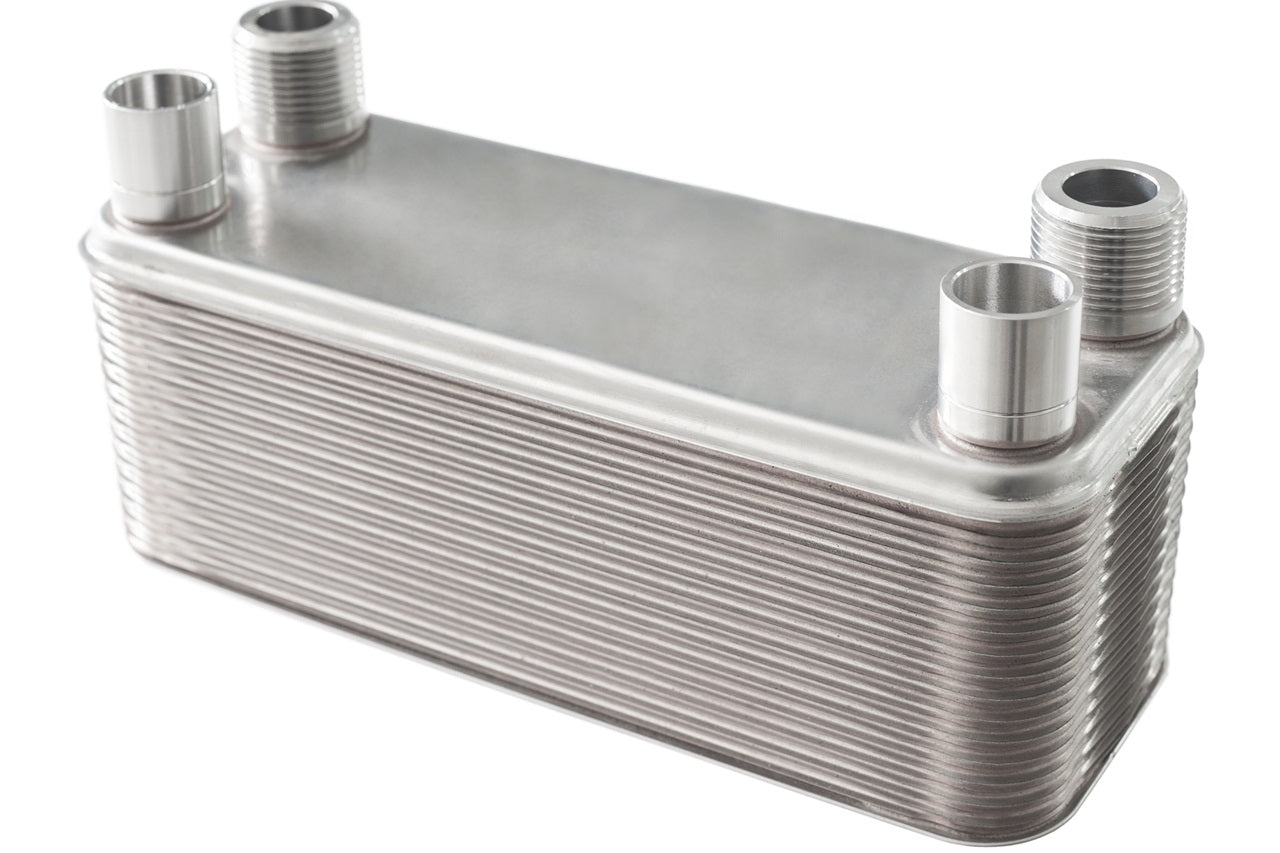A brazed plate heat exchanger is a compact and efficient solution for transferring heat between different fluids. Commonly used in industrial settings, it offers high thermal performance and durability. However, like any equipment, it has advantages and limitations that should be considered before implementation. This article explores the pros and cons of brazed plate heat exchangers to help you determine if they are the right choice for your application.
Benefits of Brazed Plate Heat Exchangers
A brazed plate heat exchanger is known for its compact design. It requires less space than shell-and-tube or gasket models, making it ideal for industrial environments with limited installation space. The plates are stacked tightly, which maximizes heat transfer efficiency while keeping the unit lightweight and easy to integrate into different systems.
Discover our most popular product categories – find what you need today!
- Air to Water Heat Exchangers
- Water to Air Heat Exchangers
- Plate Heat Exchangers
- Oil Coolers & Intercoolers
- Tankless Water Heaters
Another key benefit is its high thermal performance. The narrow channels between the plates create turbulence, enhancing heat exchange between fluids. This design minimizes energy loss, making the system more efficient. This efficiency in heat exchanger water-to-air applications ensures that heat is transferred quickly and evenly, reducing operational costs over time.
Unlike traditional industrial heat exchangers, brazed plate models do not require gaskets. This eliminates the need for regular gasket replacements and reduces maintenance costs. The lack of gaskets also means they can withstand higher pressures and temperatures, making them more durable in demanding industrial settings.
- Compact size saves space and simplifies installation
- High thermal efficiency lowers energy consumption
- No gaskets reduce maintenance and extend service life
- Suitable for high-pressure and high-temperature applications
Space-Saving Design and Easy Installation
Many industrial facilities have limited space for equipment installation. A brazed plate heat exchanger is much smaller than a shell-and-tube unit but delivers similar or even better thermal performance. This makes it preferred for compact machinery, HVAC systems, and water-to-air intercooler applications.
Due to its lightweight design and minimal connection points, brazed plate models are straightforward to install. Unlike large industrial heat exchangers, which require additional support structures, brazed plate models can often be mounted directly to a frame or existing system components. This reduces setup time and allows for quicker integration into an industrial process.
Additionally, their simple design reduces installation errors. Since they have fewer parts than gasketed models, there is less risk of leaks or misalignment. This makes them a practical choice for industries that require reliable and efficient cooling technology without extensive installation procedures.
- Smaller footprint compared to traditional heat exchangers
- Lightweight design makes handling and transport easier
- Requires fewer connections, reducing installation complexity
- Minimal risk of leaks due to brazed construction
Energy Efficiency and Cost Savings
One of the biggest advantages of a brazed plate heat exchanger is its ability to maximize heat transfer while minimizing energy loss. The corrugated plates create turbulence, ensuring that fluids interact efficiently. This results in better thermal performance with lower energy input, reducing operating costs.
This efficiency is particularly beneficial in heat exchanger water-to-air applications. The plates allow heat to be transferred quickly, ensuring optimal temperature control. This makes them ideal for industries where maintaining consistent temperatures is essential, such as manufacturing, HVAC, and food processing.
The long-term cost savings are also significant. Businesses can lower their utility bills because these units require less energy to operate. The reduced need for maintenance and spare parts also contributes to overall cost efficiency.
- High thermal efficiency reduces energy consumption
- Effective temperature control in water-to-air intercooler applications
- Lower operational costs due to reduced energy use
- Fewer maintenance expenses compared to gasketed models
Maintenance and Durability Factors
A brazed plate heat exchanger requires less maintenance than gasketed models. Since it has no gaskets, fewer parts can wear out over time. This makes it a reliable option for industries that need continuous operation with minimal downtime.
However, maintenance challenges can arise if the fluids used contain impurities. Debris or scale buildup can clog the narrow channels between the plates, reducing heat transfer efficiency and, in some cases, requiring the entire unit to be replaced. Installing proper filtration before the exchanger can help prevent these issues.
Durability is another important factor. The brazing process makes these heat exchangers highly resistant to pressure and temperature fluctuations. However, they are not as easy to repair as traditional industrial heat exchangers. If a unit becomes damaged, it must often be replaced rather than repaired.
- No gaskets mean fewer maintenance requirements
- Requires filtration to prevent clogging from debris
- Highly durable but not easily repairable if damaged
- Long service life when used in clean fluid applications
Limitations and Potential Drawbacks
Despite their advantages, brazed plate heat exchangers are unsuitable for every application. One major drawback is their sensitivity to contamination. Because they have narrow channels, fluids containing dirt, scale, or solid particles can cause blockages, reducing efficiency and leading to costly replacements.
Another limitation is the lack of serviceability. Brazed plate models are permanently sealed, unlike gasketed models, which can be disassembled for cleaning. If internal fouling occurs, the unit cannot be disassembled for maintenance. This means that additional filtration systems are necessary in environments with contaminated fluids.
Material compatibility is another factor to consider. These heat exchangers are commonly made from stainless steel with copper brazing. While suitable for many applications, they may not work well with aggressive chemicals or certain refrigerants. In such cases, alternative materials like nickel-brazed or titanium plate exchangers may be needed, which can increase costs.
- Susceptible to clogging in contaminated fluid environments
- Cannot be opened for internal cleaning or repair
- May not be compatible with all chemicals or refrigerants
- Additional filtration may be required to prevent fouling

